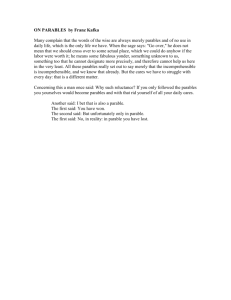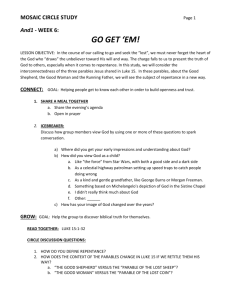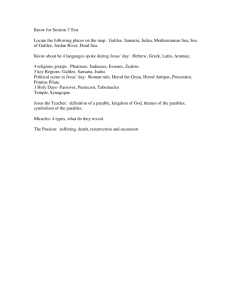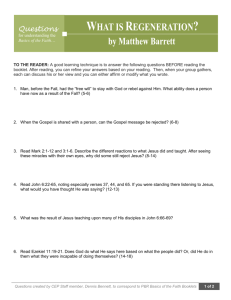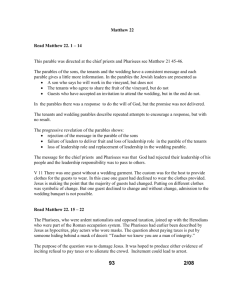The Parables of the Lost Sheep, Lost Coin, & Lost Son
advertisement
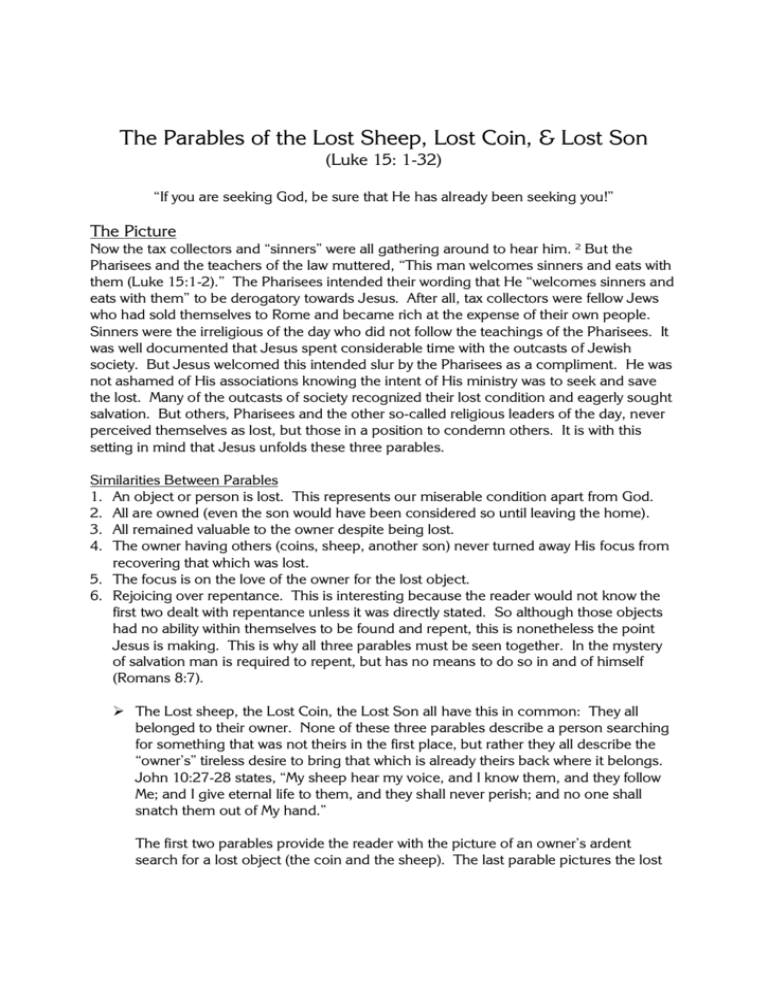
The Parables of the Lost Sheep, Lost Coin, & Lost Son (Luke 15: 1-32) “If you are seeking God, be sure that He has already been seeking you!” The Picture Now the tax collectors and “sinners” were all gathering around to hear him. ² But the Pharisees and the teachers of the law muttered, “This man welcomes sinners and eats with them (Luke 15:1-2).” The Pharisees intended their wording that He “welcomes sinners and eats with them” to be derogatory towards Jesus. After all, tax collectors were fellow Jews who had sold themselves to Rome and became rich at the expense of their own people. Sinners were the irreligious of the day who did not follow the teachings of the Pharisees. It was well documented that Jesus spent considerable time with the outcasts of Jewish society. But Jesus welcomed this intended slur by the Pharisees as a compliment. He was not ashamed of His associations knowing the intent of His ministry was to seek and save the lost. Many of the outcasts of society recognized their lost condition and eagerly sought salvation. But others, Pharisees and the other so-called religious leaders of the day, never perceived themselves as lost, but those in a position to condemn others. It is with this setting in mind that Jesus unfolds these three parables. Similarities Between Parables 1. An object or person is lost. This represents our miserable condition apart from God. 2. All are owned (even the son would have been considered so until leaving the home). 3. All remained valuable to the owner despite being lost. 4. The owner having others (coins, sheep, another son) never turned away His focus from recovering that which was lost. 5. The focus is on the love of the owner for the lost object. 6. Rejoicing over repentance. This is interesting because the reader would not know the first two dealt with repentance unless it was directly stated. So although those objects had no ability within themselves to be found and repent, this is nonetheless the point Jesus is making. This is why all three parables must be seen together. In the mystery of salvation man is required to repent, but has no means to do so in and of himself (Romans 8:7). The Lost sheep, the Lost Coin, the Lost Son all have this in common: They all belonged to their owner. None of these three parables describe a person searching for something that was not theirs in the first place, but rather they all describe the “owner’s” tireless desire to bring that which is already theirs back where it belongs. John 10:27-28 states, “My sheep hear my voice, and I know them, and they follow Me; and I give eternal life to them, and they shall never perish; and no one shall snatch them out of My hand.” The first two parables provide the reader with the picture of an owner’s ardent search for a lost object (the coin and the sheep). The last parable pictures the lost object with an understanding of his condition that seeks reconciliation with the Father. All three parables were meant to be taken together. Jesus communicated them that way which gives us keen insight on how they should be viewed. In order to get the whole picture of what Jesus was communicating the three parables must be understood together. These parables reveal insight into the salvation process. Compatabalism is illustrated. In the first two parables God seeks what is already His, but is lost. In the last parable the son (who is the father’s also) comes to the place where he recognizes his lostness and seeks out the father. Initially, he considers reconciliation on his own terms, “Make me like one of your hired servants.” But upon his journey home he must have had ample time to reconsider this approach and simply states, “Father, I have sinned against Heaven and against you. I am no longer worthy to be called your son.” His humility was complete. No demands, just a humble recognition of unworthiness and repentance. Compatabalism is demonstrated through God’s sovereign election of souls and man’s obligation to heed the command, “Follow me!” In the mystery of salvation God chooses individuals to salvation (Eph. 1:4-5, 11; Rom. 8:29-30; John 6:37,40), but man is called upon to humble himself, repent and trust Christ alone for salvation. He is held morally responsible for his decision (cf. Acts 4:27-28; 2 Cor. 5:10; Rom. 14:12). Who’s Who & What’s What The lost sheep represents – unsaved sinners. We all, like sheep, have gone astray, each of us has turned to his own way (Isaiah 53:6). The Shepherd represents – God. The lost coin represents – unsaved sinners. The woman represents – God. I cannot stress enough how the analogy of the woman searching for the lost coin should not be stretched. The parable is not trying to teach that God is a woman. The younger son represents – unsaved sinners. The older son represents – The Pharisees and the teachers of the Law. The Father represents – God. NOTE: Some have seen the Trinity in these three parables: Jesus being the shepherd seeking His lost sheep. God the Father represents the father in the last parable. And the woman who lights the lamp and searches the house being the Holy Spirit, the One who illumines the heart and mind so that salvation of the sinner is possible. This is a stretch and is probably beyond the scope of the intent of the parables, but nonetheless, all three members of the Trinity are involved in the salvation process. The Father plans the restoration. The Son accomplishes it by His death, burial, and resurrection. The Holy Spirit applies it to the individual by opening the sinner’s eyes to the truth of the Gospel, which brings repentance. Common misunderstandings regarding the parables Misunderstandings: God is in a hopeless position as far as the salvation process goes. His hands are tied. He is at the mercy of the sinner. God has to wait for man to make the initial move and hope that he will trust him as Savior. Man, must within himself choose to trust Jesus as Savior. At the very least it is thought that people come to God in different ways – some God draws to Himself, and others are able to come on their own. Truth: Man does not seek God on his own and has no ability to do so (Romans 3:10-12; 8:7; Eph. 2:1). Salvation is by grace through faith and not of ourselves (Eph. 2:8-10). We were chosen before the foundation of the world (Eph. 1:4-11). More on this can be found in the sheet on election. What is the focus of these three parables? The focus is on finding and bringing back that which was lost. Although God does the seeking and the saving, salvation does not occur without humility, repentance and an understanding of our unworthiness. What is the point(s) of these parables? 1. God has an incredible love for the lost. 2. Repentance is a key element in the salvation process. Saying you’re sorry is not repentance. Feeling bad about what you’ve done is not repentance. Saying you’ve sinned is not repentance. Repentance is making a 180° turn from what you were doing wrong, and doing right. (e.g. Hosea 14:1-2) 3. Both the Divine side and human side of salvation are seen. 4. A direct shot at the religious leaders of the day. They were those…who were confident of their own righteousness and looked down on everybody else…(Luke 18:9). Jesus leaves the door open for the Pharisees to repent…but will they? Actually, Nicodemus seems to have had a true conversion for he lovingly helped prepare Jesus’ body for burial (cf. John 19:39 ff.). It is also seen in Acts (15:5) that some from Pharisees were converted after the death of Christ. “We are never so like God as when we rejoice at the salvation of sinners. We are never so like Satan as when we despise those who are thus Converted and think ourselves superior to them.”¹ ~James Montgomery Boice~ ----------------------------¹Boice, James Montgomery. The Parables of Jesus. P. 56.
